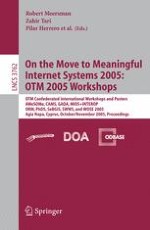2005 | Buch
On the Move to Meaningful Internet Systems 2005: OTM 2005 Workshops
OTM Confederated Internationl Workshops and Posters, AWeSOMe, CAMS, GADA, MIOS+INTEROP, ORM, PhDS, SeBGIS, SWWS, and WOSE 2005, Agia Napa, Cyprus, October 31 - November 4, 2005. Proceedings
herausgegeben von: Robert Meersman, Zahir Tari, Pilar Herrero
Verlag: Springer Berlin Heidelberg
Buchreihe : Lecture Notes in Computer Science
